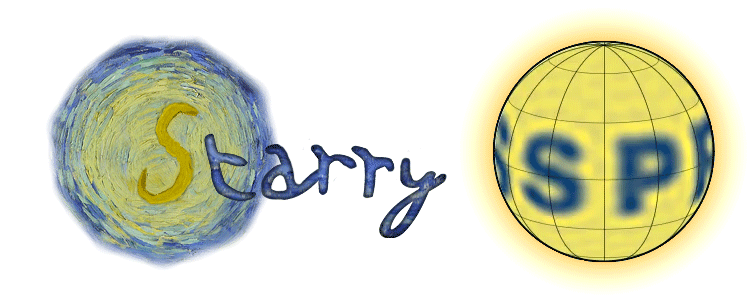Interpretable Gaussian processes for stellar light curves using starry.
The starry_process code implements an interpretable Gaussian process (GP)
for modeling stellar light curves. Whether your goal is to marginalize
over the stellar variability signal (if you think of it as noise)
or to understand the surface features that generated it (if you
think of it as data), this code is for you. The GP implemented here works
just like any other GP you might already use in your analysis, except that
its hyperparameters are physically interpretable. These are (among others)
the radius of the spots, the
mean and variance of the latitude distribution,
the spot contrast, and the number of spots. Users can also specify
things like the rotational period of the star, the limb darkening parameters,
and the inclination (or marginalize over the inclination if it is not known).
The code is written in Python and relies on the Theano package, so a little familiarity with that is recommended. Check out the crash course here. If you would like to report an issue or contribute to the project, please check out CONTRIBUTING.md.
The quickest way is via pip:
pip install starry-processNote that the starry_process package requires Python 3.6 or later.
Import the main interface:
from starry_process import StarryProcessDraw samples from a Gaussian process with small mid-latitude spots:
import numpy as np
import matplotlib.pyplot as plt
# Instantiate the GP
sp = StarryProcess(
r=10, # spot radius in degrees
mu=30, # central spot latitude in degrees
sigma=5, # latitude std. dev. in degrees
c=0.1, # fractional spot contrast
n=10 # number of spots
)
# Draw & visualize a spherical harmonic sample
y = sp.sample_ylm().eval()
sp.visualize(y)
# Compute & plot the flux at some inclination
t = np.linspace(0, 4, 1000)
flux = sp.flux(y, t, i=60).eval()[0]
plt.plot(t, flux)Same as above, but for high-latitude spots:
sp = StarryProcess(r=10, mu=0, sigma=10, c=0.1, n=10)Large equatorial spots:
sp = StarryProcess(r=30, mu=0, sigma=10, c=0.1, n=10)Small, approximately isotropic spots:
sp = StarryProcess(r=10, mu=0, sigma=40, c=0.1, n=10)For more information check out the full Quickstart tutorial and the complete documentation.
The code is described in this JOSS paper. It is the backbone of the Mapping Stellar Surfaces paper series, including:
- Degeneracies in the rotational light curve problem
- An interpretable Gaussian process model for stellar light curves
If you make use of this code in your research, please cite
@article{Luger2021a,
author = {{Luger}, Rodrigo and {Foreman-Mackey}, Daniel and {Hedges}, Christina and {Hogg}, David W.},
title = {{Mapping stellar surfaces I: Degeneracies in the rotational light curve problem}},
journal = {arXiv e-prints},
keywords = {Astrophysics - Solar and Stellar Astrophysics, Astrophysics - Instrumentation and Methods for Astrophysics},
year = 2021,
month = jan,
eid = {arXiv:2102.00007},
pages = {arXiv:2102.00007},
archiveprefix = {arXiv},
eprint = {2102.00007},
primaryclass = {astro-ph.SR},
adsurl = {https://ui.adsabs.harvard.edu/abs/2021arXiv210200007L},
adsnote = {Provided by the SAO/NASA Astrophysics Data System}
}
@article{Luger2021b,
author = {{Luger}, Rodrigo and {Foreman-Mackey}, Daniel and {Hedges}, Christina},
title = {{Mapping stellar surfaces II: An interpretable Gaussian process model for light curves}},
journal = {arXiv e-prints},
keywords = {Astrophysics - Solar and Stellar Astrophysics, Astrophysics - Earth and Planetary Astrophysics, Astrophysics - Instrumentation and Methods for Astrophysics},
year = 2021,
month = feb,
eid = {arXiv:2102.01697},
pages = {arXiv:2102.01697},
archiveprefix = {arXiv},
eprint = {2102.01697},
primaryclass = {astro-ph.SR},
adsurl = {https://ui.adsabs.harvard.edu/abs/2021arXiv210201697L},
adsnote = {Provided by the SAO/NASA Astrophysics Data System}
}
@article{Luger2021c,
author = {{Luger}, Rodrigo and {Foreman-Mackey}, Daniel and {Hedges}, Christina},
title = {{starry\_process: Interpretable Gaussian processes for stellar light curves}},
journal = {arXiv e-prints},
keywords = {Astrophysics - Solar and Stellar Astrophysics, Astrophysics - Earth and Planetary Astrophysics, Astrophysics - Instrumentation and Methods for Astrophysics},
year = 2021,
month = feb,
eid = {arXiv:2102.01774},
pages = {arXiv:2102.01774},
archiveprefix = {arXiv},
eprint = {2102.01774},
primaryclass = {astro-ph.SR},
adsurl = {https://ui.adsabs.harvard.edu/abs/2021arXiv210201774L},
adsnote = {Provided by the SAO/NASA Astrophysics Data System}
}








